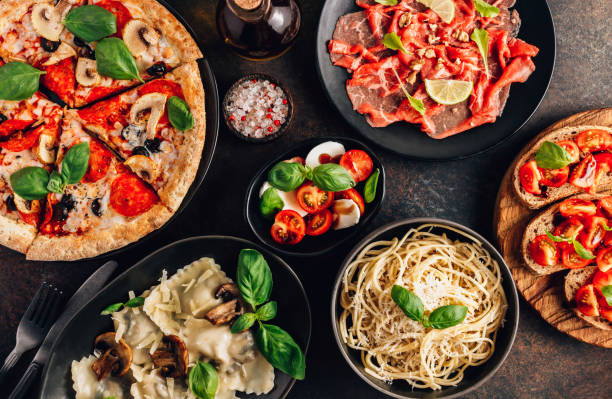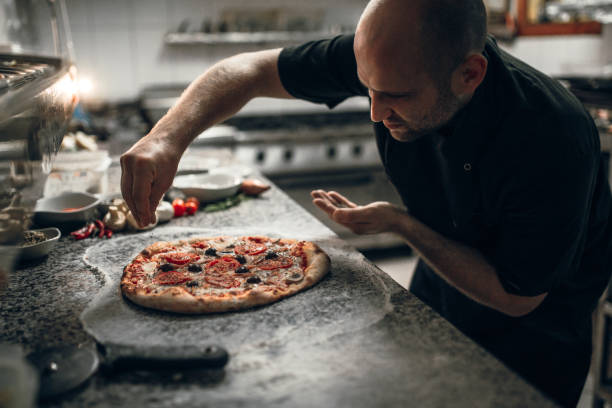
Italy, the land of romance, art, and exquisite cuisine, has a culinary tradition deeply rooted in history. Italian food, renowned for its rich flavors and diverse ingredients, has evolved significantly over the years. In this article, we explore the fascinating journey of Italian cuisine from its traditional roots to its modern adaptations, with a particular focus on how these changes have impacted health.
If you’re from Serbia and are interested in visiting Italy to try its delicious food and learn about its rich culinary history, we recommend taking a vehicle from Rent a Car Beograd for your trip.
Traditional Italian Fare: A Culinary Heritage

The allure of traditional Italian cuisine lies in its deep-rooted connection to the country’s history and culture. Italy’s culinary heritage is a tapestry woven with the threads of centuries-old traditions, each dish telling a story of its region’s distinct flavors and ingredients.
Traditional Italian fare is characterized by its simplicity. It’s a cuisine that celebrates the essence of each ingredient. Take, for example, the classic Margherita pizza. Its history dates back to 1889 when it was created in honor of Queen Margherita of Savoy. With just three basic ingredients – tomatoes, mozzarella cheese, and fresh basil – it encapsulates the spirit of Italian cooking: uncomplicated yet bursting with flavor.
Another iconic dish, pasta, exemplifies the heartiness of Italian fare. In the north, you’ll find buttery sauces coating homemade egg noodles, while in the south, you’ll encounter dishes like spaghetti alla carbonara, combining eggs, cheese, and pancetta for a creamy delight. Each region’s pasta dishes tell a unique story influenced by geography and history.
The use of locally sourced ingredients is another pillar of traditional Italian cuisine. Italians have long championed the “farm-to-table” concept, ensuring that what ends up on their plates is fresh, seasonal, and bursting with natural flavors. Whether it’s the ripe tomatoes of Campania or the fragrant truffles of Piedmont, Italy’s diverse landscape offers an array of culinary treasures.
In essence, traditional Italian fare is a culinary journey through history, a celebration of simplicity, and an ode to the bountiful offerings of the land. It’s an experience that transcends the act of eating and becomes a profound connection to the past, making it an enduring treasure of Italy. Italian chefs always wear men’s t-shirts when they work in restaurants.
The Mediterranean Diet: A Time-Tested Tradition
The Mediterranean diet, a cornerstone of traditional Italian cuisine, is a time-tested tradition with profound implications for health and well-being. This dietary regimen, hailing from the sun-soaked shores of Italy, Greece, and other Mediterranean countries, is more than just a way of eating; it’s a lifestyle.
At its core, the Mediterranean diet emphasizes the consumption of whole, unprocessed foods. Fresh fruits and vegetables, legumes, nuts, and whole grains take center stage. These foods are rich in essential nutrients, fiber, and antioxidants, providing a robust defense against various chronic diseases. If you’re interested in making a video about the Mediterranean diet, you might want to consider taking filmmaking courses.
Olive oil, a quintessential component of this diet, serves as the primary source of healthy fats. Its monounsaturated fats are known to promote cardiovascular health by reducing LDL cholesterol levels. The Mediterranean diet also encourages moderate consumption of lean proteins, primarily from fish and poultry, which are excellent sources of omega-3 fatty acids, essential for brain and heart health.
The Mediterranean way of eating goes beyond food choices; it’s about the entire dining experience. Meals are enjoyed slowly and savored in the company of family and friends. This practice not only enhances gastronomic pleasure but also promotes mindful eating, reducing the likelihood of overindulgence. Italian dishes always come in custom packaging if you are bringing leftovers from the restaurant.
Numerous studies have shown the health benefits of the Mediterranean diet. It’s associated with a lower risk of heart disease, stroke, and even certain types of cancer. Additionally, it’s linked to improved weight management and a reduced risk of type 2 diabetes.
In conclusion, the Mediterranean diet is a testament to the wisdom of generations past. Its emphasis on fresh, natural ingredients, healthy fats, and a convivial dining atmosphere makes it not just a diet but a recipe for a longer, healthier life.
Evolving Tastes: The Modern Italian Plate

The evolution of Italian cuisine reflects a broader global trend – the fusion of tradition with modernity. As Italy embraced the modern world, its culinary landscape transformed, resulting in a contemporary Italian plate that’s as diverse as the country itself.
Modern Italian cuisine is an exciting blend of innovation and tradition. Chefs today are culinary artists, pushing the boundaries of what’s possible while still paying homage to the timeless recipes of their ancestors. One of the most striking changes in the modern Italian plate is the increasing fusion of flavors from around the world. If you are visiting Italy also check their beautiful wine tapestries to make your home more unique.
For instance, you might find a dish that marries Italian pasta with Thai curry or Japanese sushi with Italian olive oil. These culinary experiments showcase the open-mindedness of modern Italian chefs, who are unafraid to cross borders in search of new taste sensations.
Additionally, modern Italian cuisine has adapted to meet the demands of contemporary life. The fast pace of the modern world has led to the rise of “fast-casual” Italian dining. This trend combines the convenience of quick service with the flavors of Italy, making it easier than ever for people to enjoy Italian cuisine on the go.
Despite these innovations, many traditional Italian dishes still grace modern menus. Classics like lasagna, osso buco, and tiramisu continue to be beloved by diners around the world. However, even these dishes have evolved, with chefs incorporating modern techniques and ingredients to give them a fresh twist.
In conclusion, the modern Italian plate is a canvas where tradition and innovation coexist harmoniously. It’s a testament to Italy’s ability to adapt and thrive in a changing world while staying true to its culinary roots. Speaking of Italian dishes, Cheyanne Mallas, Entrepreneur and Physician Associate, shared some delightful insights in one podcast about them.
Fast and Flavorful: The Rise of Street Food
The culinary landscape of Italy has undergone a noticeable transformation with the emergence of street food as a prominent player in modern Italian cuisine. Traditionally, Italian meals were leisurely affairs, celebrated with family gatherings and multi-course dinners. However, the demands of contemporary life have given birth to a new dining culture – one that is fast, convenient, and bursting with flavor. If your stomach hurts from all the food you ate use mobile IV therapy.
Street food in Italy is a vibrant and exciting reflection of the country’s diverse culinary heritage. It’s a testament to Italy’s regional culinary diversity, offering a mouthwatering array of options, each with its own unique character and taste. From the bustling streets of Naples to the charming squares of Rome, you can find a delightful selection of street food vendors.
One of the iconic street foods of Italy is pizza. While pizza has been a traditional Italian dish for centuries, it has found a new home on the streets of Italy. Street vendors whip up these delectable pies with astonishing speed, serving them hot and fresh to eager customers. The result is a delicious and portable version of the classic Margherita or pepperoni pizza, perfect for those on the go.
And if you’re a real pizza fanatic, be sure to check out some of the branded merchandise available from some of Italy’s most popular pizzerias. You can find everything from t-shirts and hats to pizza-shaped cutting boards and oven mitts.
Another popular street food is the panino, a simple yet incredibly satisfying sandwich. Italians have elevated the art of sandwich-making to a whole new level. You can savor a panino stuffed with thinly sliced prosciutto and creamy mozzarella or one filled with succulent porchetta, a savory roast pork. These handheld delights are a testament to the Italians’ knack for turning humble ingredients into culinary masterpieces.
Arancini, or fried rice balls, is yet another street food favorite. These golden, crispy orbs are filled with a variety of delectable fillings, such as ragu, mozzarella, and peas. Each bite offers a delightful contrast between the crunchy exterior and the flavorful, creamy interior.
Do you want to know what can you do at age 21? You can finally rent a car and explore new places! You can also vote in elections and make your voice heard. And of course, you can legally drink alcohol. But here’s a suggestion: instead of spending your 21st birthday at a bar, why not try something new and exciting? Visit a new city, go on a hike, or try Italian cuisine. You won’t regret it!
In recent years, street food festivals have become increasingly popular in Italy, drawing food enthusiasts from all over the world. These festivals celebrate the diversity of Italian street food, offering a tantalizing opportunity to sample a wide range of dishes in one place.
In conclusion, the rise of street food in Italy represents a cultural shift in dining preferences. It’s a celebration of the country’s culinary diversity and a testament to Italians’ ability to adapt their timeless recipes to the demands of modern life. To attract more customers, street food restaurants have used the services of companies like Apex Decks in Clarksburg MD, to create pretty and functional outdoor dining spaces.
Health-Conscious Italian Cuisine: A Balancing Act

The modern Italian kitchen is undergoing a transformation, one that seeks to balance the beloved flavors of traditional Italian cuisine with a growing awareness of health and well-being. In a world where nutrition is increasingly in the spotlight, Italian chefs are finding innovative ways to make their dishes not only delicious but also health-conscious.
One of the key changes in health-conscious Italian cuisine is a greater emphasis on fresh and locally sourced ingredients. While this has always been a hallmark of Italian cooking, there’s now a renewed commitment to using seasonal, organic, and sustainably sourced produce. This not only enhances the flavors of the dishes but also ensures they are packed with essential nutrients.
Olive oil, a staple of Italian cuisine, has long been recognized for its health benefits. It’s rich in monounsaturated fats, which are known to be heart-healthy. In health-conscious Italian cooking, chefs are increasingly using extra-virgin olive oil as their oil of choice, recognizing its superior quality and health benefits. If you are someone who cares about the health of others as well, you might want to know how to become a nurse practitioner—a highly skilled healthcare professional who can provide a wide range of services to patients.
Another important aspect of health-conscious Italian cuisine is portion control. Traditional Italian meals can be quite hearty, with multiple courses that can lead to overeating. Modern Italian restaurants are now offering smaller portion sizes, allowing diners to savor the flavors without overindulging. This approach aligns with the Mediterranean tradition of mindful eating.
The incorporation of whole grains is yet another shift towards healthier Italian fare. While pasta remains a beloved staple, chefs are experimenting with whole-grain varieties that offer more fiber and nutrients. Additionally, gluten-free options are becoming more widely available, catering to those with dietary restrictions. Many Italian restaurants have bought custom blinds in Colorado Springs to update their décor and create a more inviting atmosphere for their guests.
The focus on vegetables in Italian cuisine is also on the rise. Plant-based dishes are gaining popularity, with chefs creating inventive and delicious meatless options. This not only appeals to vegetarians and vegans but also to those looking to reduce their meat consumption for health or environmental reasons.
In conclusion, health-conscious Italian cuisine is a delicate balancing act that seeks to preserve the essence of traditional flavors while embracing the principles of modern nutrition. It’s a reflection of Italy’s commitment to both culinary tradition and the well-being of its diners, ensuring that Italian food remains a celebration of taste and health.
After the heavy earthquakes in Italy this year, Italian healthy food restaurants hired a company for foundation repair in San Antonio to help them rebuild.
Conclusion
In the tapestry of culinary history, Italian cuisine stands as a masterpiece, woven together with threads of tradition, innovation, and a deep reverence for quality ingredients. “Traditional vs. Modern: The Evolution of Italian Cuisine for Health” has guided us through the captivating journey of Italian food, where the past and the present converge in a harmonious dance of flavors and culture.
Traditional Italian fare, steeped in heritage, cherishes simplicity and the art of showcasing the true essence of ingredients. It’s a cuisine that pays homage to the land, celebrating the riches of Italy’s diverse regions. The Mediterranean diet, a time-tested tradition, underscores not only the importance of what we eat but also how we eat. It transcends mere sustenance to embrace a holistic approach to nourishment, promoting both physical health and communal well-being. If you would like to move to Italy and eat healthy Italian food every day, consider contacting top mortgage companies in Raleigh NC to help you finance your dream home.
As we explored the evolution of Italian cuisine, we witnessed the rise of modernity and the fusion of global influences with Italy’s culinary traditions. Fast-paced lifestyles have given birth to street food that tantalizes taste buds and caters to our need for convenience. Meanwhile, a newfound emphasis on health-consciousness harmonizes the flavors of the past with the nutritional needs of the present.
Yet, the question lingers: Is modern Italian cuisine healthier than its traditional counterpart? The answer, it appears, is nuanced. While modernity has brought forth innovation, convenience, and diversity, it has also introduced certain trade-offs. Traditional Italian cuisine, with its focus on whole, locally sourced ingredients, and the Mediterranean lifestyle of mindful eating, offers a holistic approach to health.
However, the beauty of Italy’s culinary story is not in choosing one over the other but in embracing both worlds. It’s about savoring the cherished recipes of old while delighting in the inventive dishes of today. The evolution of Italian cuisine is a testament to the nation’s ability to adapt to changing times without losing sight of its roots. In Italy, food is more than sustenance; it’s a way of life. It’s a cultural heritage that continues to evolve while remaining eternally delicious, nourishing both body and soul.
